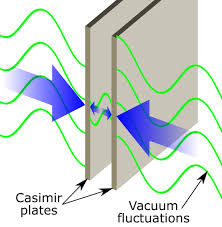Casimir Effect:

Scientists recently discovered how to control the Casimir Effect and supercharge tiny machines.
- The Casimir effect is a physical phenomenon that occurs in quantum field theory where two uncharged conducting plates, positioned very closely, experience an attractive force known as the Casimir force.
- This force arises from the quantum vacuum fluctuations of the electromagnetic field between the plates.
- In quantum field theory, the vacuum is not truly empty but rather filled with fleeting virtual particles and fluctuations in electromagnetic fields.
- Even though the space between the plates may seem empty, it’s actually filled with virtual particles constantly appearing and disappearing.
- These particles influence the electromagnetic field, leading to a net attraction between the plates.
- The effect was first predicted in 1948 by Dutch physicist Hendrik Casimir during his research on colloidal solutions.
- This effect has been experimentally verified and finds applications in various fields, such as nanotechnology and condensed matter physics.
- It has also contributed to our understanding of fundamental physics, including the nature of vacuum energy.
- Experimental physicists have recognized its impact on micromachined devices, while advancements in instrumentation have allowed for more accurate measurements of the force




